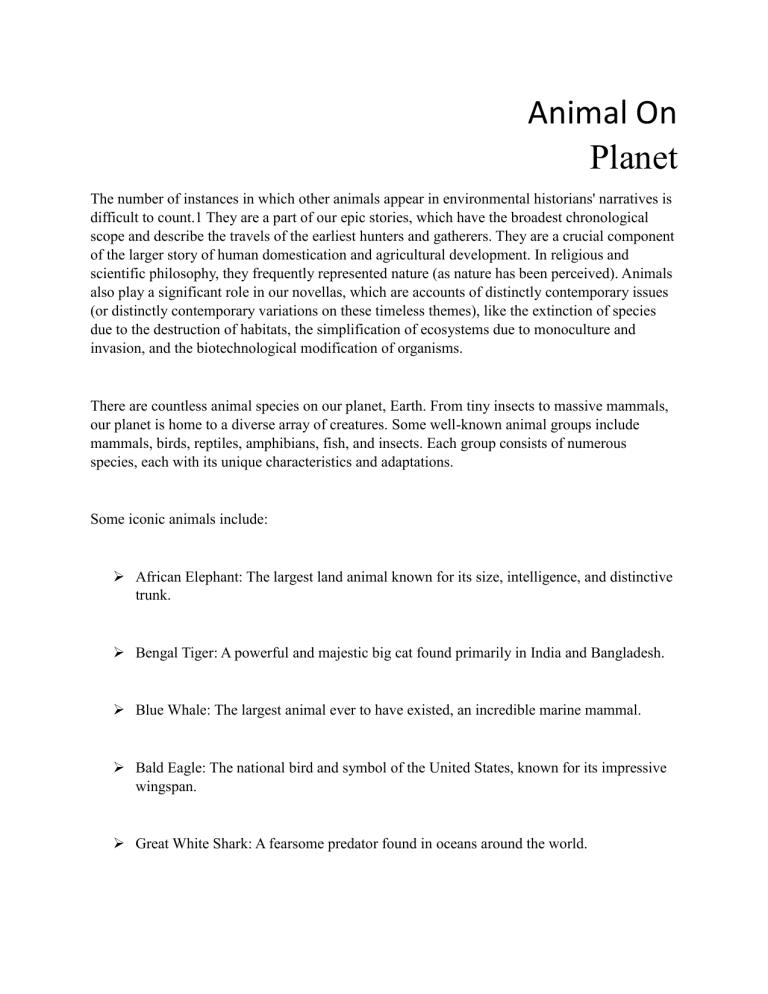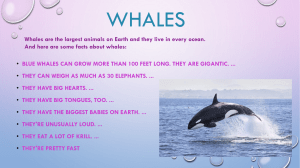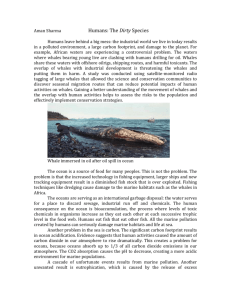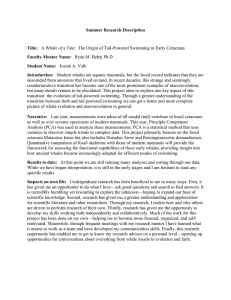
Animal On Planet The number of instances in which other animals appear in environmental historians' narratives is difficult to count.1 They are a part of our epic stories, which have the broadest chronological scope and describe the travels of the earliest hunters and gatherers. They are a crucial component of the larger story of human domestication and agricultural development. In religious and scientific philosophy, they frequently represented nature (as nature has been perceived). Animals also play a significant role in our novellas, which are accounts of distinctly contemporary issues (or distinctly contemporary variations on these timeless themes), like the extinction of species due to the destruction of habitats, the simplification of ecosystems due to monoculture and invasion, and the biotechnological modification of organisms. There are countless animal species on our planet, Earth. From tiny insects to massive mammals, our planet is home to a diverse array of creatures. Some well-known animal groups include mammals, birds, reptiles, amphibians, fish, and insects. Each group consists of numerous species, each with its unique characteristics and adaptations. Some iconic animals include: African Elephant: The largest land animal known for its size, intelligence, and distinctive trunk. Bengal Tiger: A powerful and majestic big cat found primarily in India and Bangladesh. Blue Whale: The largest animal ever to have existed, an incredible marine mammal. Bald Eagle: The national bird and symbol of the United States, known for its impressive wingspan. Great White Shark: A fearsome predator found in oceans around the world. Monarch Butterfly: Known for its remarkable migration across North America and its vibrant orange and black wings. African Lion: The king of the savanna, known for its strength and majestic appearance. Giant Panda: An endangered bear species native to China, recognized for its distinctive black-and-white coat. Atlantic Puffin: A charming seabird with a colorful beak, known for its excellent diving abilities. Green Sea Turtle: A fascinating marine reptile that migrates vast distances and is known for its herbivorous diet. These are just a few examples, and there are countless other animals with incredible features and adaptations across the globe. Their livings Animals live in a wide variety of habitats across the Earth, ranging from forests and grasslands to deserts, oceans, and even polar regions. Here are some examples of different habitats and the animals that live in them: Forests: Forests are home to a diverse range of animals, including mammals like bears, deer, squirrels, and tigers; birds like owls, eagles, and parrots; reptiles like snakes and lizards; amphibians like frogs and salamanders; and countless insect species. Grasslands: Grasslands support animals such as bison, zebras, antelopes, prairie dogs, lions, cheetahs, and various bird species. Many grassland animals are adapted to open spaces and rely on grasses and other vegetation for food and shelter. Deserts: Desert animals have unique adaptations to cope with extreme heat and limited water resources. Examples include camels, kangaroo rats, scorpions, snakes, lizards, and certain bird species like roadrunners. Oceans: Marine environments are teeming with life. Coral reefs are home to a vast array of colorful fish, sea turtles, dolphins, and sharks. In the open ocean, you'll find whales, dolphins, seals, various fish species, and numerous marine invertebrates such as jellyfish and octopuses. Polar Regions: The Arctic and Antarctic regions are home to animals adapted to survive in extremely cold conditions. These include polar bears, penguins, seals, walruses, Arctic foxes, reindeer, and a variety of seabirds. Freshwater Habitats: Lakes, rivers, and wetlands are home to diverse aquatic animal species such as fish (e.g., trout, bass, and catfish), amphibians like frogs and salamanders, turtles, crocodiles, waterfowl, and a wide range of aquatic insects. These are just a few examples, and there are many more types of habitats and the animals that live within them. Each habitat supports unique ecological communities with species adapted to thrive in their specific environments. The biggest one on planet. that title goes to the Blue Whale (Balaenoptera musculus). The Blue Whale is the largest known animal to have ever existed. On average, they can reach lengths of about 82 to 105 feet (25 to 32 meters) and can weigh up to 200 tons or more. Blue Whales are massive marine mammals found in oceans around the world, and their size is truly awe-inspiring. Blue Whales are not known to intentionally hurt or attack humans. They are filter feeders and primarily consume small shrimp-like animals called krill by taking in large mouthfuls of water and filtering out the krill using baleen plates in their mouths. Blue Whales are generally gentle creatures and are known for their peaceful nature. However, due to their enormous size, accidental collisions between Blue Whales and boats or ships can occur, which can potentially cause harm to both the whale and humans involved. It's important for boats and ships to maintain a safe distance and adhere to guidelines and regulations to minimize the risk of such accidents. It's also worth noting that approaching or interacting with Blue Whales or any other wild animals in their natural habitat should be done with caution and respect. Maintaining a respectful distance and not causing any disturbance is important to ensure the well-being of both the animals and humans involved.




